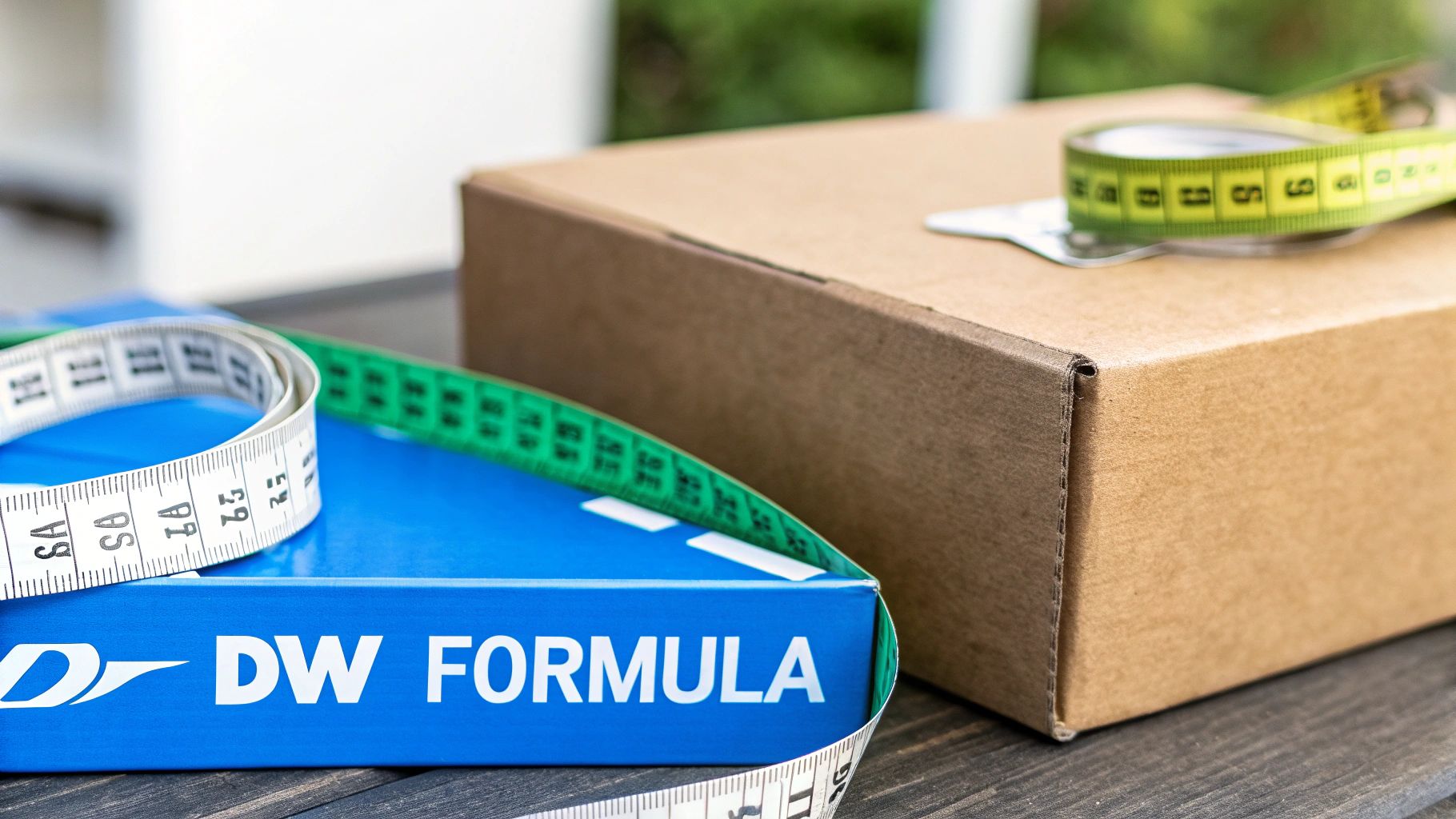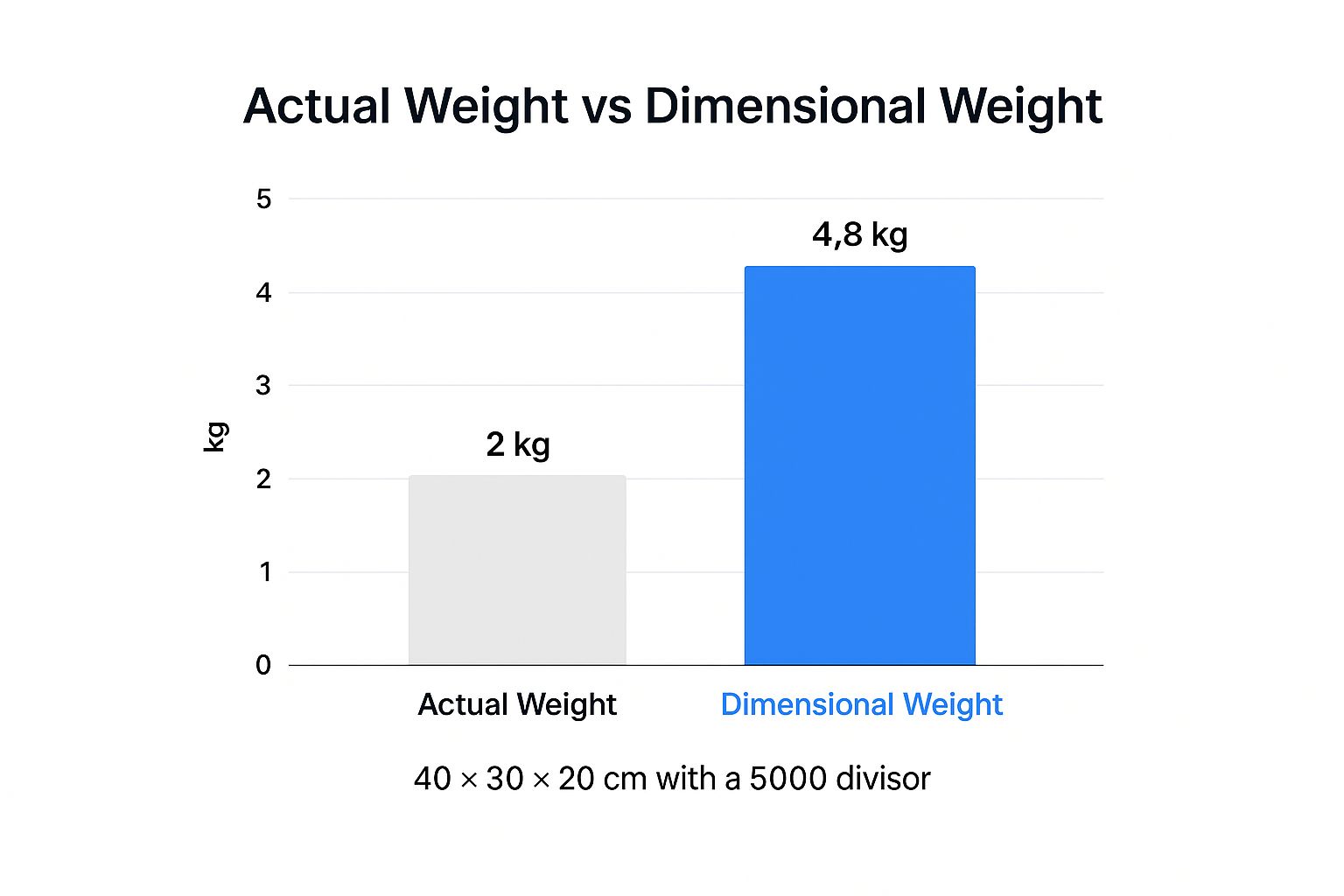To calculate dimensional weight, you just need to multiply your package's length x width x height (in inches). Then, you take that total and divide it by a special number called a DIM divisor. This simple formula gives you the "billable weight," which carriers then compare to the actual weight, charging you for whichever is higher.

Ever shipped something big but light—like a case of paper towels or a set of fluffy pillows—and got hit with a surprisingly high bill? You've just met dimensional weight, or DIM weight as it's often called. It's a pricing model that focuses on how much space a package takes up on a truck or plane, not just what it weighs on a scale.
Think of a delivery truck as a giant puzzle. Carriers want to fit as many pieces (your packages) into that space as they can. A big box of pillows takes up the same room as a small, dense box of hand tools, but it would generate a lot less revenue if carriers only charged for its actual weight. This is exactly why DIM weight pricing was born.
Years ago, shipping was all about actual weight, which meant carriers were losing money on bulky, lightweight shipments. To solve this, all the major carriers rolled out dimensional weight pricing to make sure they were getting paid fairly for the cargo space being used.
For anyone running an online store, getting a handle on logistics is just as important as having great e-commerce web design. Mastering DIM weight isn't just about learning a shipping rule; it's fundamental to protecting your profit margins.
The core idea is simple: The billable weight is the greater of a package’s actual weight and its dimensional weight. If the DIM weight is higher, you're paying for the space, not the pounds.
This has a direct impact on your bottom line. Shipping a few small items in an oversized box means you're paying to ship empty air—a costly mistake that can eat into your profits on every order.
To help you get a firm grasp on these concepts, here’s a quick-reference table breaking down the essential terms.
Getting these terms straight is the first step. Once you understand the "why" behind them, you can start making smarter decisions that save you money.
Knowing how to work with this metric is a true business advantage. It empowers you to:
By getting a handle on this concept, you can turn a potential expense into a competitive edge. To see how the numbers play out with real-world examples, you can dive deeper into our complete guide to dimensional weight pricing. This knowledge is key to making smarter decisions that boost your bottom line.

Alright, let's get into the math. While the concept behind dimensional weight is pretty simple, the specific numbers—especially the DIM divisor—are what really drive your final shipping cost. Carriers use a straightforward formula to figure it out, but that divisor can change depending on your shipping contract and where the package is headed.
For most domestic shipments here in the U.S., you'll be working with this formula:
(Length x Width x Height) / 139 = Dimensional Weight in Pounds
That 139 divisor is the standard for retail and ground services with major carriers like UPS and FedEx. A word of advice from experience: always measure the longest point on each side of your box and round up to the nearest whole inch. Even a small miscalculation can bump you into a higher billable weight.
Let's say you're shipping something that's big but doesn't weigh much—a classic DIM weight scenario. Imagine a box of lightweight but bulky lampshades.
First, you calculate the total volume: 20 x 18 x 16 = 5,760 cubic inches. This number represents the space your package takes up.
Now, you plug that into the standard domestic formula: 5,760 / 139 = 41.36 pounds.
Carriers always round up the final DIM weight, so that becomes 42 pounds. They'll then compare the actual weight (8 lbs) to the dimensional weight (42 lbs) and charge you for whichever is higher. Suddenly, you're paying to ship a 42-pound package, not an 8-pound one. That's a huge difference.
Things get a little different when you ship internationally or if you're a high-volume shipper with a negotiated rate. For these scenarios, you'll often see a more favorable DIM divisor of 166.
Let's run the numbers on our lampshade example again, but this time with the better divisor. The calculation is now: 5,760 / 166 = 34.7 pounds, which rounds up to a billable weight of 35 pounds.
Just by changing that one number, the billable weight dropped by a full 7 pounds. This is why understanding which divisor applies to your shipment is absolutely critical. The difference between 139 and 166 might seem minor on paper, but it directly impacts your bottom line on every single package affected by DIM weight.
Trying to run these numbers manually for every order is a recipe for headaches and errors. It's why so many businesses use automated tools. You can use a free dimensional weight shipping calculator to quickly see how different divisors will affect your costs without breaking out the calculator every time.
Just when you think you’ve mastered the DIM weight formula, there’s a catch. The truth is, every major shipping carrier—UPS, FedEx, and USPS—plays by its own set of rules. This isn't just a minor detail; the specific DIM divisor a carrier uses, which services it applies to, and even the package size that triggers DIM pricing can all vary.
This is exactly where businesses get stung by unexpected shipping charges. A lower divisor makes your dimensional weight higher, inflating your costs. A higher divisor, on the other hand, is your friend—it can lower your billable weight. Knowing these differences is absolutely crucial for picking the most cost-effective carrier for any given package.
To avoid overspending, you need to get into the weeds of each carrier's policy. The differences might seem small on paper, but they add up fast when you're shipping hundreds or thousands of packages a year.
Here’s a look at how the big three handle DIM weight pricing and what you need to know to make smarter shipping decisions.
The key takeaway? You simply can't assume one carrier's rules apply to another. Always double-check the current DIM divisor and any volume thresholds before you ship, especially when comparing rates between carriers.
The image below really drives home how a package's dimensional weight can dwarf its actual weight.

As you can see, the billable weight for this shipment is more than double its actual weight. That's DIM weight in action.
Things get even more complicated when you ship across borders. The standard US divisor of 139 isn't the global norm. International air freight often uses a more generous divisor of 166. This single difference can dramatically change your shipping costs on global orders.
This industry-wide push toward DIM pricing has sparked a wave of innovation in packaging. Smart companies are now investing in better materials and right-sizing technology to fight back. In fact, simply using right-sized packaging can slash dimensional weight charges by up to 20%—a massive saving. For more deep dives into optimizing your freight, check out the resources over at OTFS.net.
Ultimately, choosing the right carrier is a strategic move that hinges entirely on your package's profile: its size, weight, and where it's headed. By getting a handle on these carrier-specific rules, you can dodge costly surprises and confidently pick the service that delivers the best value every time.
Knowing how to calculate dimensional weight is the first step. Actually reducing it is where you start to see real money back in your pocket. Since carriers charge you for whichever is higher—the actual weight or the dimensional weight—your main goal is to make your packages as small as possible without putting your products at risk. This is where smart packaging becomes your secret weapon for protecting profit margins.
The most common and costly mistake we see is the "one-size-fits-all" box. Shipping a small item in a big box is literally paying to ship air, and with DIM pricing, that air gets expensive fast. Every single inch you can shave off your package dimensions directly cuts your billable weight and your final shipping cost.
The single most powerful tactic is to right-size your boxes. This just means matching your packaging as closely as you can to the product inside, leaving just enough room for essential padding.
Think about it: say you sell a small electronic device that measures 6" x 4" x 2". Instead of automatically reaching for a standard 10" x 8" x 6" box, find one that’s closer to 7" x 5" x 3". This seemingly tiny change makes a huge dent in the package's cubic volume, which is the heart of the DIM weight calculation. Investing in a variety of box sizes pays for itself by letting you pick the most efficient option for every single order.
Here's a thought: not everything needs a box. For items that aren't fragile—like apparel, bedding, or other soft goods—boxes are often complete overkill and just add unnecessary bulk and cost.
For certain products, you can get even more aggressive with space-saving. If you sell anything compressible like puffy jackets, pillows, or blankets, vacuum-sealing is a total game-changer.
By sucking the air out of the product before you put it in a mailer or box, you can slash its volume by 50% or more. This directly lowers your dimensional weight and leads to some serious cost savings, especially on textiles that would otherwise be considered bulky.
This one technique can turn what would have been a very expensive shipment into a much more reasonable one. These tactics are just the beginning when it comes to fighting back against rising shipping fees. For a deeper dive, check out our guide on how to reduce shipping costs for your small business.
Let's be real—manually calculating DIM weight and comparing rates for every order is a nightmare. It's slow, tedious, and a recipe for mistakes.
Modern shipping software completely automates this. It can instantly calculate both the actual and dimensional weight for an order and then shop rates across all your carriers (UPS, FedEx, USPS) to pinpoint the absolute cheapest option in seconds. This tech takes the guesswork out of the equation and ensures you're never overpaying because you missed a weird carrier rule or a better packaging choice. It's an indispensable tool for any e-commerce business serious about keeping shipping costs under control.

Here’s a painful lesson many eCommerce sellers learn the hard way: a simple measurement mistake can wipe out your profit on an order. Carriers are incredibly precise, and if their automated scanners find a discrepancy between your declared dimensions and the actual package size, you're getting hit with an expensive billing adjustment.
Learning to measure like a carrier is your best defense against these entirely preventable fees. Trust me, it’s worth the extra few seconds.
One of the most frequent errors I see is measuring the inside of a box instead of the outer dimensions. You have to remember what the carrier cares about—the total space your package hogs on their truck. Always measure from the absolute outermost points. This includes any bulges or slightly misshapen sides, because their high-tech scanners will capture the maximum length, width, and height, no exceptions.
Key Takeaway: Always round your measurements up to the nearest whole inch. If a side measures 12.25 inches, you must record it as 13 inches. Carriers don't deal in fractions, and rounding down is a guaranteed way to get a surprise surcharge on your next invoice.
So what about items that don't fit into a perfect rectangle, like a guitar or a piece of exercise equipment? You can't just measure the item itself. For these situations, carriers use what's known as the "box-it" method.
They calculate the dimensions by measuring the item as if it were enclosed in the smallest possible rectangular box. To get this right, you need to find the three most extreme points:
Imagine a virtual cube dropped over the item, and then measure that cube. This is the only way to accurately calculate dimensional weight for non-standard shapes and avoid frustrating billing disputes.
A classic example is a teddy bear. Its dimensions aren't just its height. You must measure from the tip of its ear down to its toe (height), from the edge of one outstretched arm to the other (width), and from its back to the tip of its nose (depth). It's a small detail that trips up a lot of shippers.
Preventing these errors is all about protecting your profit margins. It also ensures a smoother shipping process, free from the delays and headaches that come with carrier billing adjustments. While you're optimizing your shipping process, it's also helpful to understand how carrier schedules can impact your deliveries; you can learn more about this in our guide on how late USPS delivers.
Even after you get the hang of the formulas, certain real-world scenarios can still make you second-guess yourself. We see it all the time. Let’s clear up some of the most common questions that pop up once shippers start paying close attention to dimensional weight.
Think of this as your quick-reference guide for those tricky “what if” situations. Getting these details right builds confidence and gives you full control over your shipping costs, no matter what you're sending.
This is a classic question that trips up a lot of businesses. When you're shipping something oddly shaped—like a bicycle helmet or a piece of art—carriers don't try to measure its organic curves.
Instead, they measure the item as if it were inside the smallest possible rectangular box that could hold it.
Your job is to find the dimensions of that imaginary box. Measure the absolute longest, widest, and tallest points of the item, and use those three numbers for your L x W x H calculation. It’s the industry-standard "box-it" method.
For soft goods like apparel, the best move is often to skip boxes entirely. A poly mailer shrinks the dimensions so much that dimensional weight rarely even comes into play.
No, and this is a make-or-break distinction for your budget. The billable weight is what you actually pay for. It’s always the greater of two numbers:
If your box of t-shirts has an actual weight of 5 pounds but its dimensional weight is 12 pounds, you’re paying to ship a 12-pound package. This is exactly why optimizing your box size is non-negotiable.
The carrier always charges for the higher number. Your goal is to keep the dimensional weight as close to the actual weight as possible to avoid paying to ship empty space. This single concept is the key to mastering your shipping budget.
Absolutely. This is one of the biggest cost-saving levers you can pull as your business grows. Negotiating a custom, more favorable DIM divisor is standard practice for high-volume shippers. If you're sending a lot of packages, you have leverage.
A higher divisor (say, 166 instead of 139) directly lowers your calculated dimensional weight on every single package. The savings add up fast. Don't be shy about bringing this up with your carrier rep once your volume picks up—it’s a normal part of negotiating a better shipping contract.
Trying to manage all these nuances manually is a huge drain on your time and resources. Simpl Fulfillment uses advanced 3D scanning technology to capture precise dimensions automatically, ensuring you get the most accurate and cost-effective rate on every order. Learn how we can handle your logistics so you can focus on growth.